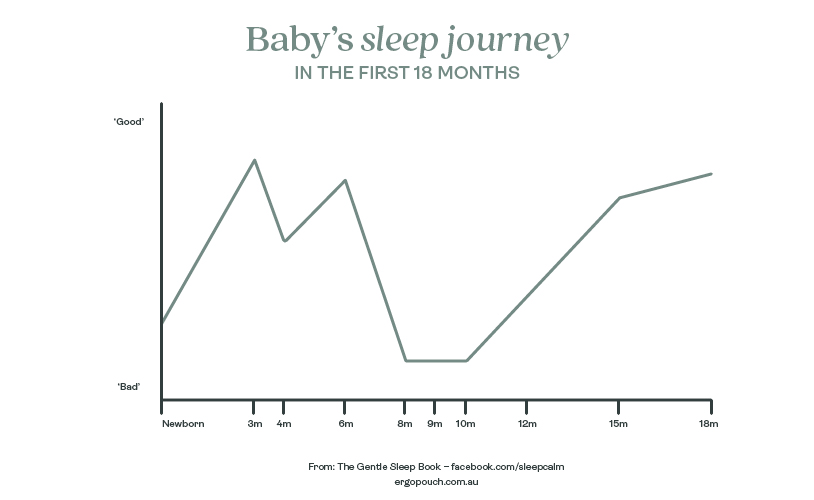
Raising a little one can be a joyful journey, but when our babies endure setbacks in their sleeping habits, it can make life challenging. Knowing how to cope during infant sleep regression is not common knowledge, so if you’re scratching your head, you’re not alone.
The good news is that slumber regression is entirely expected, and most of all, it’s temporary. As our kids grow and change, they learn loads of new skills. All of this can be overwhelming for them at times, and when tykes are progressing in one area, they can regress in others.
Fortunately, there are ways to manage the situation and cope with these obstacles.

What is a sleep regression?
A regression in rest is when your baby suddenly has a shift in their sleeping patterns. Unfortunately, this is not a one-time occurrence and may happen multiple times throughout their early childhood.
Regressions in slumber are exhibited through multiple behaviors like trouble falling asleep at night, sudden separation anxiety, or waking up frequently after they’ve been snoozing through the night. It can also appear as a sudden shift in behavior or mood, as your tot could be drained of energy and exhibit fussier behavior.
At certain pivotal ages, your child is going through enormous developmental growth. Simple things to adults are big moments for children, like first words, first steps, and rolling over. These significant milestones in their development also require tremendous amounts of nutrients and energy to happen, and as a result, can be draining on your tot.
Fortunately, these setbacks are temporary. They usually only last about two to six weeks, while your child is enduring these drastic changes. After, your kiddo should return to their standard snooze patterns.
When do sleep regressions happen?
Sleep regressions often happen when your child is going through significant changes developmentally. This usually occurs around the ages of four months, six months, and anywhere between eight to ten months. They can also appear again at 18 months.
These are periods when your tyke is going through large bursts in growth. They may have started to learn new skills like recognizing faces, rolling over, absorbing language, or becoming more mobile.
Learning these skills has an enormous effect on the brain, and due to these cognitive advances, your infant will often exhibit regression in behavior, including rest. Not only do these changes indicate shifts in growth, but these times are exciting for your baby as well.
They may not only show resistance to sleep itself, but they may also be eager to put their new skills to use, chattering to themselves, gripping table ledges, or exploring the world with their newfound mobility.
Ways to cope
Despite these challenging periods, there are fortunately a few ways in which to curb regression issues.
Be Flexible. It’s Temporary
It’s critical to remember while going through these difficult periods that your baby’s behavior will not last forever. While at times, incredibly disruptive and potentially worrying, these slumber setbacks are to be expected and temporary.
As you notice these issues appearing, try to be flexible, and work with your child. If they’re experiencing a bit of separation anxiety, it’s okay to cuddle them a bit longer before putting them down to sleep.
Create a Soothing Sleep Environment
Your infant has probably learned to sleep in their crib by now. However, there are a few things you can do to foster a cozy atmosphere. It’s surprisingly loud inside of a womb, and placing a white noise machine near your kiddo’s crib can help to lull their eyes closed at night. Additionally, blackout curtains can be a game-changer. Keeping the room dark and cool could help to curtail any midnight wakings when they’re not feeling desperate. Keep a Routine Maintaining a schedule is one of the best ways to keep a healthy routine in place. Most parents will likely echo this sentiment. Following a routine is not only beneficial for your whole family, but it lets your baby know what’s happening and what’s expected of them.
Providing a safe, predictable environment for our munchkins allows them to live a life with minimal stress and clear boundaries. Additionally, this fosters healthy relationships and personal stability, letting them develop to their utmost potential.
Put Baby Down Drowsy
It may not always be apparent or possible, but try and look out for sleep cues to get your baby to bed during their slumber window. Waiting too long can lead to increased fussiness and tears at bedtime.
Sleep cues could be yawning, rubbing eyes, disinterest (zoning out), or fussiness. When you notice them, try your best to take advantage of this opportunity before they get a second wind.
Ask for Help
According to a study on parental burnout from Sarah Hubert and Isabelle Aujoulat of the Psychological Sciences Research Institute of Belgium, mothers often feel a “great sense of duty, [are] often in doubt about their own abilities, and [are] very self-demanding.” This lack of compassion with ourselves can make us feel like we have to juggle it all. However, managing things alone rarely benefits anyone.
Not only is asking for help wise and alleviates pressure, but it fosters good delegation skills. Additionally, other parents might appreciate a glimpse of vulnerability and will likely be able to relate. Friends and family often like to be included and asking for help could be a good opportunity for them to be a part of your baby’s life.
Provide Fuel
As your infant goes through growth spurts they may need a bit more sustenance to get them through the days and nights. Their engines are churning at an all-time high during these developmental bursts, and they’ll need all the fuel they can get. They may be in the form of snacks throughout the day, larger meals, longer feedings, or dream feeding at night.
Conclusion
Coping with sleep regression in a newborn can be rough. There will inevitably be countless nights that you are woken up due to a needy child, and that’s to be expected and completely normal.
However, you’re not alone in your struggles. There is lots of information available for free online that can aid in your journey. We know it won’t be easy, but with a bit of practice, we’re optimistic you’ll feel more in control.
Helpful Products for a Snoozing Baby
Installing blockout blinds can work wonders for a fussy newborn. Since it takes some time for a circadian rhythm to develop after being born, it may help to keep the room they sleep in dark and cozy. Following a routine will assist with this as well, as your infant should start associating certain activities with bedtime. If they are consistently going into a dim room before bed, they’ll typically be able to fall asleep with more ease.
Wrapping up your little bundle of joy in a burrito-like structure can provide an often needed sense of security and comfort. It may sound silly, but for nine months, your baby was growing inside a toasty, warm environment of limited size. Securely wrapping them in a swaddle sack can mimic the sensation of when they were snug as a bug in the womb, allowing them to close their eyes peacefully.
Once your munchkin begins to roll over, it’s time to transition them to an “arms out” swaddle position, which means wrapping them with their arms free. However, your baby could feel vulnerable if not introduced to this smoothly, which is where the butterfly cardi comes in handy. The adjustable cardigan can help transition your tot to an arms-out position with minimal sleeping disruptions, allowing them more mobility while still feeling warm and snug.




